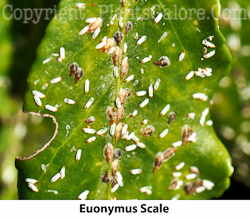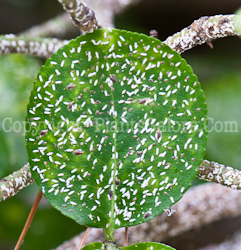|
 A
common problem on winter creeper (Euonymus
fortuneii) plants is an insect named Euonymus scale (Unaspis euonymi).
Scale insects attach themselves to the stems or leaves of plants and suck
juices from them. In large numbers, they can cause death to twigs and branches.
In extreme cases, the entire plant may die. A
common problem on winter creeper (Euonymus
fortuneii) plants is an insect named Euonymus scale (Unaspis euonymi).
Scale insects attach themselves to the stems or leaves of plants and suck
juices from them. In large numbers, they can cause death to twigs and branches.
In extreme cases, the entire plant may die.

Scale appears as white to yellow raised spots on the leaves and
stems. In heavy infestations, branches and leaves may be covered with flattened,
white, scaly bumps. Leaves may turn yellow and fall from the plant. The
overall vigor of the plant declines over time.
 It is important to know the life cycle of this insect to obtain effective
control. For most of the year, the adult scales are firmly attached to
the plant and are covered by a protective shell. They do not move around
the plant. During this time, they are not vulnerable to typical insecticide
sprays (except for horticultural oils). It is important to know the life cycle of this insect to obtain effective
control. For most of the year, the adult scales are firmly attached to
the plant and are covered by a protective shell. They do not move around
the plant. During this time, they are not vulnerable to typical insecticide
sprays (except for horticultural oils).
 During late spring or early summer, the scales produce young called
crawlers. The tiny crawlers move to a new location on the plant,
attach themselves and then grow a shell. During this limited time, they
are vulnerable to insecticides. During late spring or early summer, the scales produce young called
crawlers. The tiny crawlers move to a new location on the plant,
attach themselves and then grow a shell. During this limited time, they
are vulnerable to insecticides.

As with most problems, the best control is prevention. Inspect
shrubs each year and treat the problem while the numbers of scales are
low.
Once the stems of the plant are covered with white scale, the population
is high and the plant is being stressed. In extreme cases, the shrub may
need to be replaced or cut to the ground and allowed to re-grow.
Two approaches may be taken to reduce the number of scales on the plant:
1. A dormant (horticultural) oil spray may be used on both the adult
and the crawlers. In April, plants may be sprayed with a highly refined
product such as Volck oil or Sunspray Ultra Fine oil at the dormant
rate. The temperature must be high enough (usually 40 degrees for several
days) so that the oil will spread evenly over the branches and thus smoother
the scale insects.
2. In early June, the crawlers emerge and may be controlled by
an oil spray applied at the growing season rate (more dilute) listed on
the product. Or, they may also be treated with other
insecticides labeled for Euonymus scale.
|



